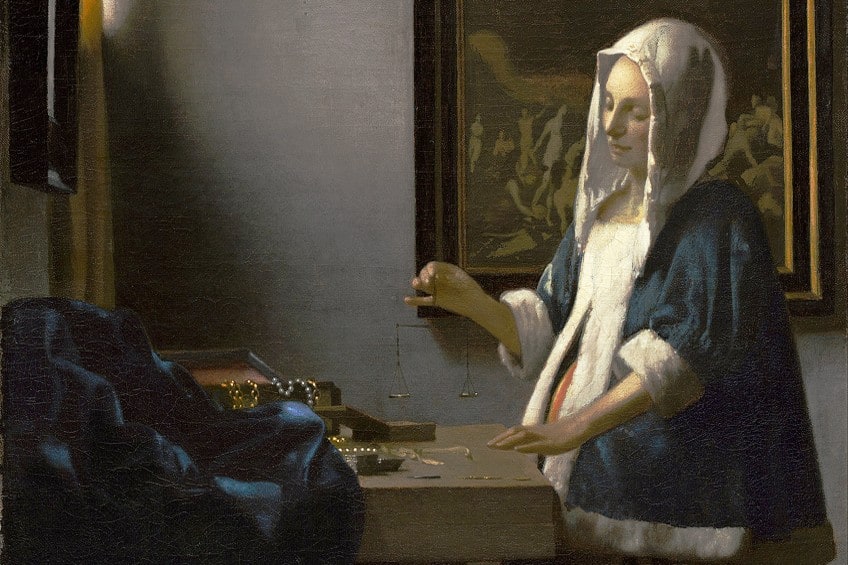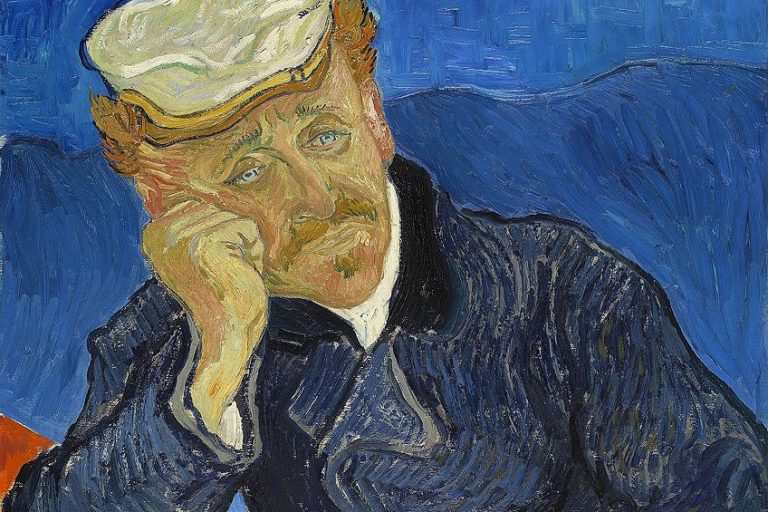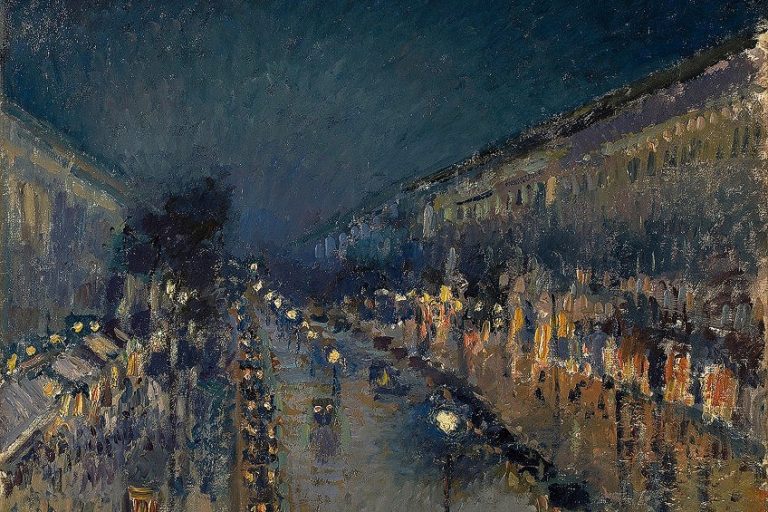“Woman Holding a Balance” by Johannes Vermeer – An Analysis
An exemplar of the Dutch art style, Woman Holding a Balance (c. 1664) by Johannes Vermeer is one of the artist’s most famous works. But what is the woman doing in the painting Woman Holding a Balance? If you have ever wondered about the answer to this question and are interested in learning more about this iconic painting, the following article will also provide further analysis of this painting.
Artist Abstract: Who Was Johannes Vermeer?
While there is not extensive information about Johannes Vermeer’s life, his year of birth was 1632, and his date of baptism was on October 31; he died on December 15, 1675. He was born in Delft, which is a city in the Netherlands, and his parents were Reijnier Janszoon, who was his father, and Digna Baltens, who was his mother.
He was married to Catharina Bolnes and the couple reportedly had 15 children, of which several died.
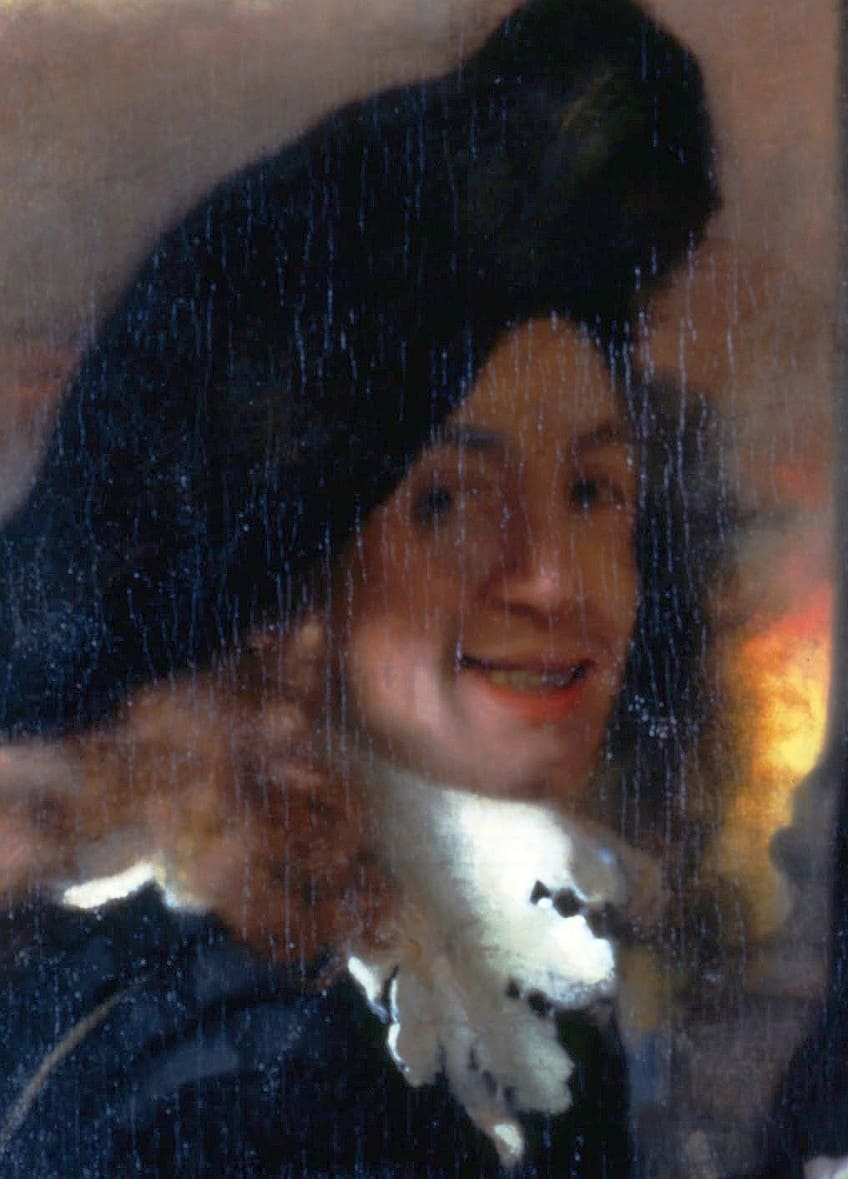
Vermeer was also part of the Guild of Saint Luke and there are reportedly 35 existing paintings attributed to him, however, he was believed to have produced several more that are not in existence. Some of his famous paintings include The Milkmaid (1658), Woman With a Water Jug (1660-1662), The Girl With a Pearl Earring (c. 1665), and The Art of Painting (1668).
Woman Holding a Balance (c. 1664) by Johannes Vermeer in Context
| Artist | Johannes Vermeer |
| Date Painted | c. 1664 |
| Medium | Oil on canvas |
| Genre | Genre painting |
| Period / Movement | Dutch Golden Age |
| Dimensions (cm) | 42.5 x 38 |
| Series/Versions | N/A |
| Where Is It Housed? | National Gallery of Art, Washington D.C., United States |
| What It Is Worth | The exact value is uncertain |
This article will start with a brief contextual overview of important aspects of the painting Woman Holding a Balance by Johannes Vermeer, together with a detailed formal analysis of the Dutch painter’s artistic style.
Contextual Analysis: A Brief Socio-Historical Overview
Woman Holding a Balance (c. 1664) by Johannes Vermeer was believed to be inspired by the oil painting by the Dutch artist Pieter de Hooch titled Interior with a Woman Weighing Gold Coin (c. 1664), however, the accuracy of this has been questioned due to some questioning if the artists influenced each other.

De Hooch’s painting appears similar in subject matter, a woman standing over a table and holding a balance in her right hand, her clothing is also like Vermeer’s woman’s clothing, which was the style of clothes attributed to middle/upper-class women.
Woman Holding a Balance: A Vanitas Painting
So, what is the woman doing in the painting Woman Holding a Balance? This question can be answered according to how it has been described as a Vanitas, which was commonly depicted as still life paintings in the Netherlands. The word Vanitas originates from Latin and means “worthlessness” and “emptiness”. It is often associated with the idea of “transiency”, which is life’s shortness and fleeting nature. Importantly, Vanitas is also associated with materialism and “vanity”, raising questions about its value of it and ultimately its hollowness, especially during a time when religion was a strong and significant part of society and life.
There is extensive scholarly research about this topic, some scholars believe Vermeer painted “Woman Holding a Balance” as a vanitas, notably because the mirror is directly in line with the woman so that she can look at her own reflection, and her observing all her possessions on the table.
However, other theories suggest that it can also reflect the ideas of “self-knowledge” and aspects that are more enlightened than ego-based. The balance could symbolize a balance between the material world and higher knowledge. Furthermore, The Last Judgment painting to the woman’s right is also suggestive of the abovementioned concepts, of life and death and ultimate judgment, and the woman being composed in how she lives her life. These depictions have often been described as “positive” in nature and the woman as someone who understands the underlying implications.
Formal Analysis: A Brief Compositional Overview
The formal analysis will start with a discussion of the subject matter of Woman Holding a Balance by Johannes Vermeer, which will then be followed by how the art elements like color, texture, line, shape, form, and space compose it.
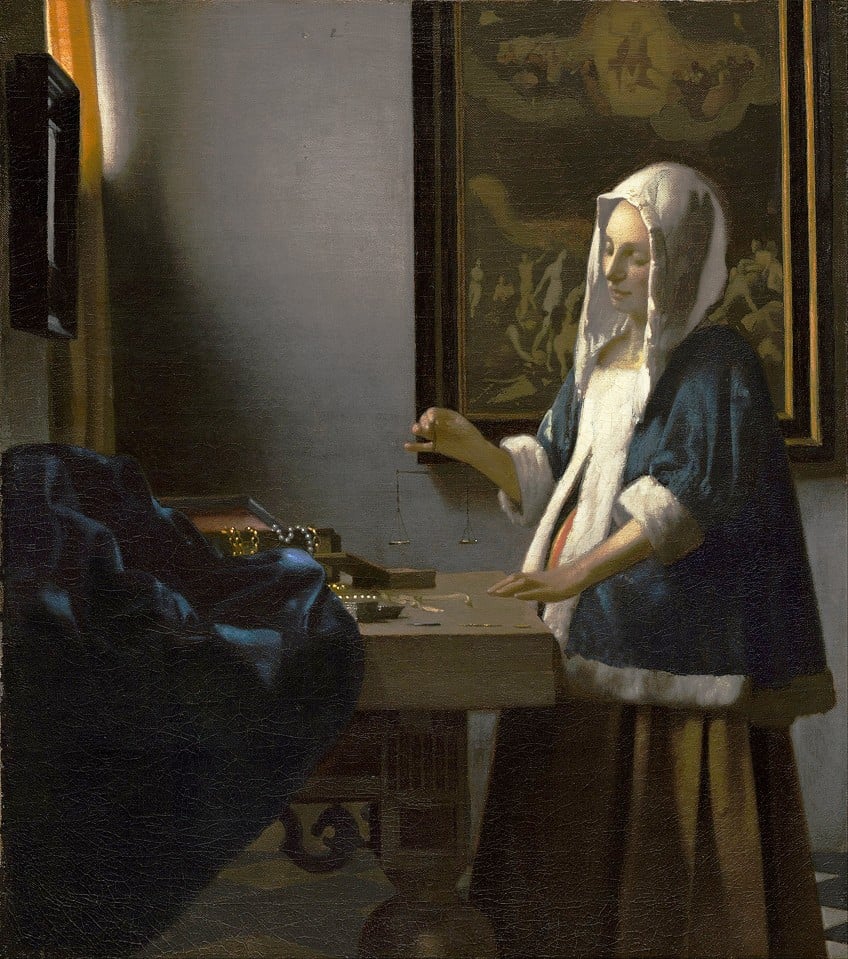
Subject Matter: Visual Description
In Woman Holding a Balance, Johannes Vermeer depicts an interior scene of a woman standing in front of an ornate wooden table, holding, and looking at a balance. There are various items on the table, namely a jewelry box opened with pearl and gold chain necklaces hanging out of it. There appears to be another pearl necklace on the table and what appears as weights for the balance, which the woman is holding up and looking at, or possibly coins.
There is also a smaller box with an open lid, which is believed to possibly be the box for the balance. There is a large blue tablecloth crumpled on the table’s top left corner, which is in the lower-left corner of the composition.
The woman is standing with her left hand’s forefingers slightly resting on the edge of the table and in her right hand, between her thumb, index, and middle fingers are the stringy handle on which a balance hangs. The woman appears to be in a deep contemplative state while looking at the balance, her head is slightly tilted to her left side, which is towards us, the viewers. Her eyelids appear to be mostly closed and we cannot see her eyes staring at the balance.

The woman is wearing what appears to be a long dress, described as a “mustard-yellow” color with a blue velvet jacket with white furry trims that hangs to just below her waist with sleeves to just below her elbow; the jacket is fastened at the woman’s upper chest area and forms a slight open slit revealing more of her dress. The jacket also has a hood attached to it that appears to be made of a more delicate white material, which is over the woman’s head.
Looking at the surroundings, the woman is standing in a room, and the floor has checkered tiles. To the woman’s right, and in our, the viewers, direct line of sight, is a large painting hanging on the wall, which depicts “The Last Judgment’s” subject matter.
In front of the woman is a smaller framed canvas, which is believed to be a mirror, and a window in her upper right corner with a long yellow curtain. The room’s walls appear in a neutral grayish color. The table is identified as having “bun-shaped feet” and was a common wooden table known as a “draw-leaf table”. Interestingly, the woman appears to be pregnant, although this has been brought into question as many scholars state that pregnant women were not frequently depicted as subject matter in art and that the illusion of pregnancy was created by the woman’s dress.
Color
Johannes Vermeer’s color scheme consists of blue, golden yellows, and more neutral tones of grays and browns. Additionally, some of the colors also echo the others, for example, the blue drapery/cloth on the table with the woman’s blue jacket and the yellow curtains with the woman’s dress. However, Vermeer has been praised for his delicate utilization of light and shading, which is evident on the wall near the window, gradually depicting the contrasts as the light shines through the window and seemingly dissipates the dark shadows on the wall.
There is also a subtle hint of yellow from the curtain on the wall as the light shines through it. The woman’s face is also gently lit up as the light beams through.
Texture
There are a variety of implied textures in Woman Holding a Balance by Johannes Vermeer, for example, the softer fluffier fur-lining and velvet fabric of the woman’s jacket as well as the smoother texture of the blue drapery/cloth on the table.
The jewelry and items on the table, including the balance, also have highlights providing it with a realistic glistening quality.
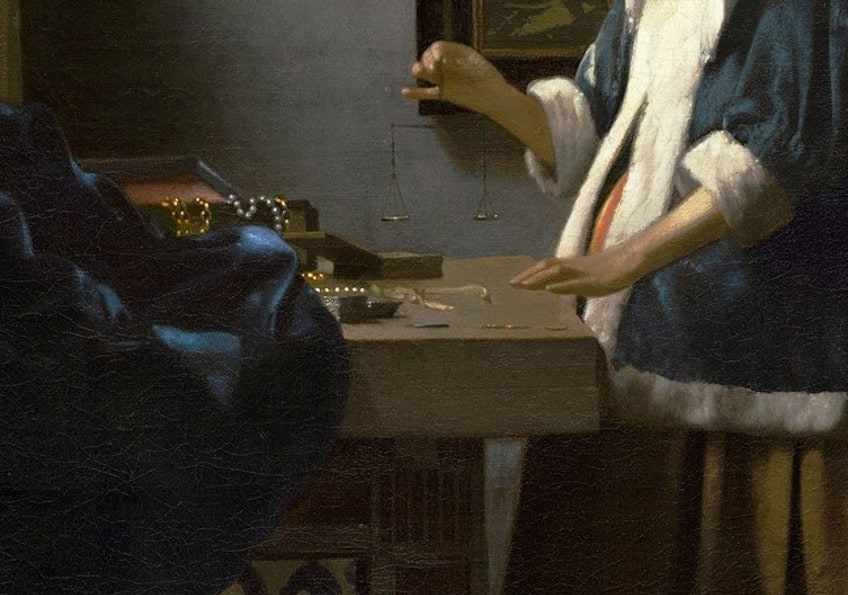
Line
A variety of lines compose Woman Holding a Balance by Johannes Vermeer, from the implied vertical line of the woman’s standing figure, which is echoed by the larger and more vertical orientation of the painting to her right as well as the yellow curtain to the horizontal lines of the table’s surface. There are also diagonal lines created by the positioning of the woman’s arms, the subtler lines from the open boxes on the table, and the directional lines implied by the light and shadows by the window.
Additionally, there are hints of curved lines under the table as well as in the folds of the fabrics.
Shape and Form
Johannes Vermeer’s Woman Holding a Balance is a naturalistic composition, in other words, it depicts mostly organic shapes and forms that occur in real life, from the woman’s figure to the fabrics. Through shading, Vermeer created a three-dimensionality in the forms versus merely depicting flat, two-dimensional shapes. Furthermore, the woman’s figure is also contrasted against the rectangular shape of the painting to her right. The bottom frame of the same painting is also lower to the left (our right) than the right (our left), which is higher.
There is unity and balance in how Vermeer placed the various forms that compose the subject matter.
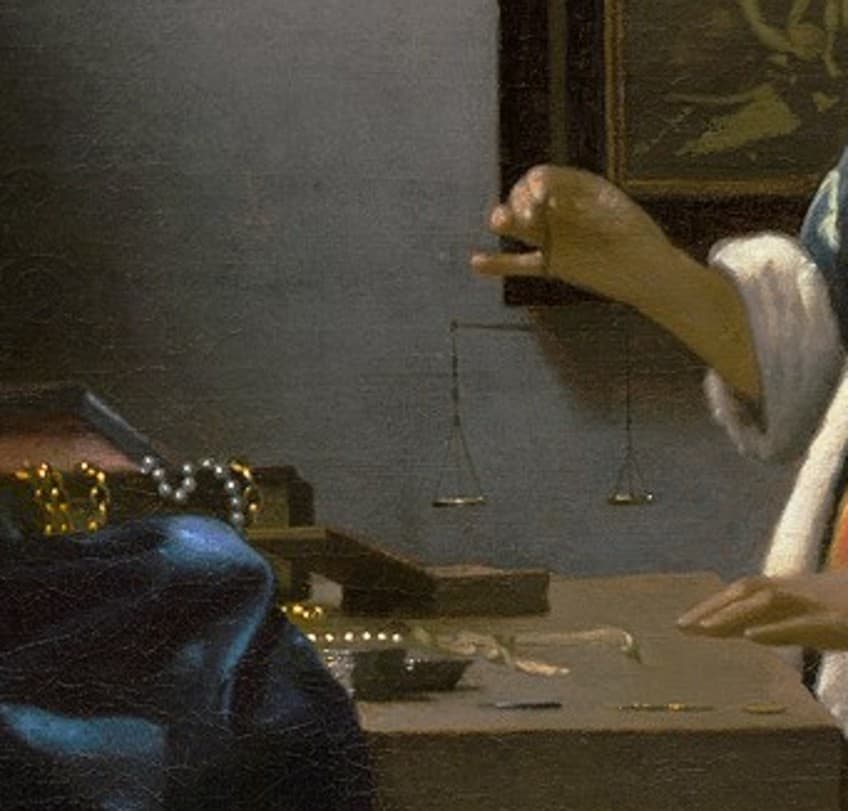
Space
Johannes Vermeer’s utilization of space may not appear calculated at first sight, but it consists of intentional placement of perspectival techniques, notably the vanishing point meeting at the woman’s fingers holding the balance, notably where her little finger is placed.
This area is also where the central point of the composition is believed to fall.
A Calm Composure
This article discussed the oil painting Woman Holding a Balance by Johannes Vermeer, who reportedly only became famous during the 19th century. He was not a popular painter during his living years, however, the scholar and art critic Etienne Joseph Théophile Thoré, otherwise known as Willem Bürger, helped disseminate more knowledge about Vermeer and his artistic oeuvre.
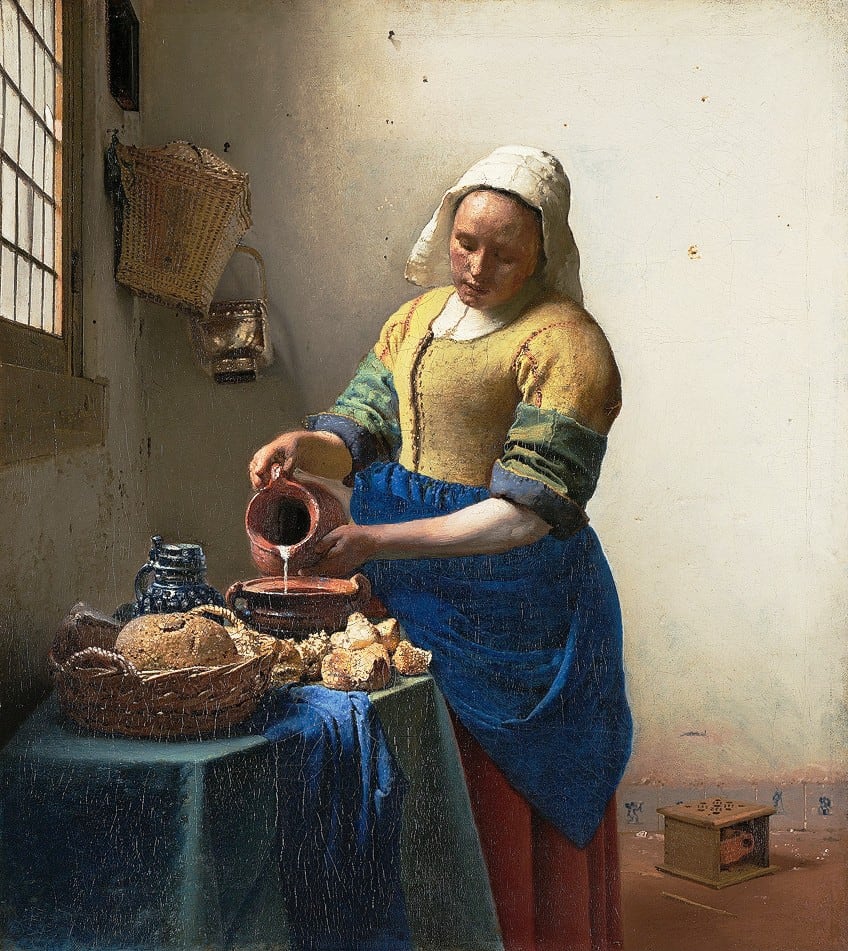
Vermeer was known for painting genre scenes of figures engaged in everyday activities inside a room, including a woman holding and looking at a balance, he also portrayed a woman pouring milk, a woman drinking wine, a girl playing music, and more, but what is often attributed to these everyday activities was the artist’s keen eye for detail to what he painted and why each object was painted.
Through the every day, Johannes Vermeer explored the deeper, philosophical aspects of life, and so, in “Woman Holding a Balance”, he created a calm composure of a common activity, but which pointed beyond what the eye can see.
Frequently Asked Questions
Who Painted Woman Holding a Balance?
The Dutch artist Johannes Vermeer painted Woman Holding a Balance (c. 1664), which is an oil on canvas painting held at the National Gallery of Art in Washington D.C., the United States of America.
What Is the Woman Doing in the Painting Woman Holding a Balance?
The woman in Johannes Vermeer’s painting, Woman Holding a Balance (c. 1664), is standing in front of a table holding a balance between her fingers and looking at it in a contemplative manner. It is believed to symbolize ideas of so-called self-knowledge and wisdom.
Where Is Woman Holding a Balance Housed?
The Woman Holding a Balance (c. 1664) has been at the National Gallery of Art in Washington D.C., in the United States of America since 1942. Prior to that, it was the property of Peter A. B. Widener, who was an art collector from Philadelphia in the United States of America.
Alicia du Plessis is a multidisciplinary writer. She completed her Bachelor of Arts degree, majoring in Art History and Classical Civilization, as well as two Honors, namely, in Art History and Education and Development, at the University of KwaZulu-Natal, South Africa. For her main Honors project in Art History, she explored perceptions of the San Bushmen’s identity and the concept of the “Other”. She has also looked at the use of photography in art and how it has been used to portray people’s lives.
Alicia’s other areas of interest in Art History include the process of writing about Art History and how to analyze paintings. Some of her favorite art movements include Impressionism and German Expressionism. She is yet to complete her Masters in Art History (she would like to do this abroad in Europe) having given it some time to first develop more professional experience with the interest to one day lecture it too.
Alicia has been working for artincontext.com since 2021 as an author and art history expert. She has specialized in painting analysis and is covering most of our painting analysis.
Learn more about Alicia du Plessis and the Art in Context Team.
Cite this Article
Alicia, du Plessis, ““Woman Holding a Balance” by Johannes Vermeer – An Analysis.” Art in Context. March 23, 2023. URL: https://artincontext.org/woman-holding-a-balance-by-johannes-vermeer/
du Plessis, A. (2023, 23 March). “Woman Holding a Balance” by Johannes Vermeer – An Analysis. Art in Context. https://artincontext.org/woman-holding-a-balance-by-johannes-vermeer/
du Plessis, Alicia. ““Woman Holding a Balance” by Johannes Vermeer – An Analysis.” Art in Context, March 23, 2023. https://artincontext.org/woman-holding-a-balance-by-johannes-vermeer/.


